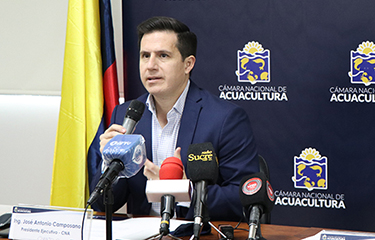In a market like the United States, where the consumption of seafood has been largely commoditized, suppliers need to go the extra mile in differentiating their offer, according to Ecuador’s National Chamber of Aquaculture (CNA) Executive President José Antonio Camposano.
Differentiating one seafood product from the next has been a challenge the CNA has been attempting to solve, Camposano told SeafoodSource.
“It’s difficult for us to do even with shrimp. We have been working hard to differentiate Ecuador with best practices, but the market sees a label that says ‘shrimp’ and then in the fine print it says it’s coming from India, Ecuador, or Thailand. There’s not much interest in differentiating,” Camposano told SeafoodSource. “One of today’s biggest flaws in the North American market is that the labeling doesn’t allow you to arrive with a new product and differentiate yourself immediately. You get placed on the supermarket refrigerator shelf as ‘seafood’ or ‘fish.’ Most of the time, the consumer doesn’t know what he’s buying. He can go to the restaurant and see the different types of fish, but he usually doesn’t say, ‘I want cod, sole, or mahi.’”
But based on its latest export figures, the CNA seems to be heading in the right direction, according to Camposano. During the first six months of the year, worldwide exports reached USD 2.08 billion (EUR 1.78 billion), up 9 percent from the same period in 2020. In the same comparable period, export volume was up 11 percent to 847 million pounds (384,192 metric tons, MT). Of the total, 24 percent was sent to the U.S., where exports doubled during January through June to USD 524 million (EUR 449 million), while volume increased 91 percent to 203 million pounds (92,079 MT). Ecuador’s shrimp exports to the U.S. in June were close in volume to those of India, which has dominated the market for the past five years.
While part of Ecuador’s shrimp surge can be attributed to the global recovery from COVID-19, the CNA has worked to reinvent and redesign the country's seafood industry. Increasing seafood consumption at the HORECA (hotel/restaurant/catering) level was combined with newfound home consumption interest and growing sales at the retail level. The chamber has also been working for years to establish the sustainability and trustworthiness of its USD 4 billion (EUR 3.42 billion) a year farmed shrimp industry.
The CNA’s first formal exercise, initiated five years ago, was the foundation of the Sustainable Shrimp Partnership (SSP), which has now been actively operating for three years.
“We wanted a platform that allows the industry to differentiate Ecuadorian shrimp, and today the SSP is a global platform, even though there are only certified farms in Ecuador. With that, we’ve managed to speak with chefs from the James Beard Foundation in New York [and] the Seafood Nutrition Partnership in Washington to dispel the myths about aquaculture,” Camposano said.
Camposano the Netflix movie Seaspiracy "painted a poor picture of the industry," but revealed misperceptions that must be addressed by the industry.
"[It was] shooting its darts everywhere. Not that I think it’s worth talking much about this film, it was very poor journalism. But where they’re right is that the aquaculture industry hasn’t been active enough in communicating what it does, and what it does right," he said.
The SSP has not chosen to focus on mass communication, but rather working with different groups of stakeholders. At first the group was chefs – specialists in the industry who were the first to understand SSP’s message, Camposano said. SNP has now extended its outreach efforts to people cooking at home who previously didn’t know how to prepare shrimp.
“In the midst of the pandemic, we designed the first culinary guide for shrimp. This isn’t a cookbook; it’s a book that looks to educate chefs or the housewife that likes to cook: first, how to identify quality shrimp over lower quality shrimp. For example, sometimes shrimp is hydrated. I don’t eat that because it loses flavor, texture, and you can tell visually,” he said.
The book – published in English and which the SSP is looking to make available on Amazon – also reviews sizes, flavors, smells, and other characteristics that differentiate shrimp available to U.S. consumers. It also offers recipes and traditional and modern gastronomic techniques for shrimp.
“It’s an industry-first initiative to educate to differentiate,” Camposano said. “What’s happening is that the consumer today is incapable of differentiating – he hears about the use of antibiotics in the industry, but he doesn’t know where they’re using antibiotics and thinks the whole industry is using it.”
Another area of focus for SNP has been traceability. The Nueva Pescanova Group’s June announcement that it will implement blockchain to trace all of its seafood was done because its Ecuadorian subsidiary ProMarisco entered into the SSP program and implemented blockchain two years ago, according to Camposano.
“They took that and decided to implement the IBM Food Trust Platform in all its operations. That happened because SSP raised resources and worked with the company for a couple of years, it was difficult,” he said. “But with that you can enter the SSP website and you can scan the QR code on the shrimp box to find out dates, which pond it was raised in, what ingredients were used, who processed the shrimp.”
Camposano said that leads to a third part of the education equation – transparency.
“It’s not just a communications pitch where you pay millions for a few seconds of airtime during the Super Bowl. It’s about educating and making the industry more transparent. When you see those commercials, you realize that other countries choose not to talk about certain issues because they have not yet implemented best practices,” Camposano said. “But we’re in 2021, and in making the market more transparent, the end-consumer can learn about the industry and make informed decisions.”
Photo courtesy of Ecuador’s National Chamber of Aquaculture







